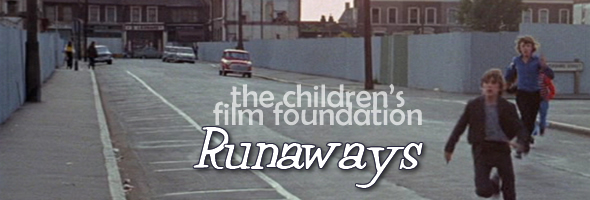
Color, 1953-1985, 200m.
Directed by Lewis Gilbert, David Eady, Frank Godwin
Starring Robin Askwith, Terence Morgan, Gary Kemp, Eugeniusz Chylek, Roy Dotrice, Liz Fraser, Sydney Tafler, Michael Balfour, Mona Washbourne, Peter Newby, Eilen Fletcher, Alan Lake, Jack McNicholl, Neville Watson, Tracey Ann Morris
BFI (DVD) (UK R0 PAL) / 1.33:1 / 1.85:1 (16:9)
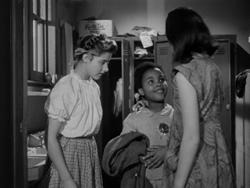 After dabbling in stories about London, racing, the supernatural, and general freakiness, the BFI's
After dabbling in stories about London, racing, the supernatural, and general freakiness, the BFI's 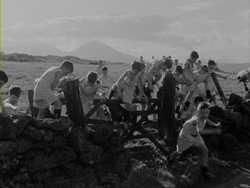 fascinating, ongoing retrospectives devoted to the films of the Children's Film Foundation turns to an obvious subject: runaways. Previous entries have been filled with tykes scrambling all over the UK, but here the theme of pursuit takes center stage with pint-sized heroes facing moral ambiguity and tricky adults from the '50s into the '80s.
fascinating, ongoing retrospectives devoted to the films of the Children's Film Foundation turns to an obvious subject: runaways. Previous entries have been filled with tykes scrambling all over the UK, but here the theme of pursuit takes center stage with pint-sized heroes facing moral ambiguity and tricky adults from the '50s into the '80s.
First up is 1953's Johnny on the Run, which is similar in tone to some of the other earlier CFF titles like The Salvage Gang. The main point of interest here is the fact that it was one of the earliest directorial efforts for Lewis Gilbert, who went on to direct Alfie, Cast a Dark Shadow, the spectacularly trashy The Adventurers, and three epic-scale James Bond films (You Only Live Twice, The Spy Who Loved Me, Moonraker). Not surprisingly, things here are on a much, much smaller scale for the story of Janek (Chylek), a Polish refugee in Scotland who flees from the home of his money-grubbing guardian, Mrs. MacGregor (Washbourne), and manages to get a dogged crooks (including Tafler) on his trail. Janek seems to find safety in a small village designed to care for international orphans, but his dream might have an expiration date coming up fast. Slight but genial, it's a fine appetizer for the set and strongly benefits from the sympathetic, fragile lead performance by Chylek, who should have gotten more jobs after this one.
Next we get 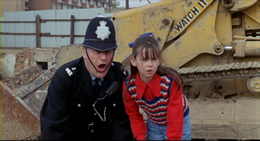 to the real jewel of the set, 1972's Hide and Seek, a wildly inventive and entertaining slice of colorful fun with an unexpected early role by a very young Gary Kemp, who would go on to co-found Spandau Ballet and star with his younger brother, Martin, in The Krays. Here he plays second fiddle to Peter Newby as Keith, a runaway from a school for troubled kids who gets branded as the "Deptford Dodger" thanks to his petty thefts. He's basically a hungry kid, though,
to the real jewel of the set, 1972's Hide and Seek, a wildly inventive and entertaining slice of colorful fun with an unexpected early role by a very young Gary Kemp, who would go on to co-found Spandau Ballet and star with his younger brother, Martin, in The Krays. Here he plays second fiddle to Peter Newby as Keith, a runaway from a school for troubled kids who gets branded as the "Deptford Dodger" thanks to his petty thefts. He's basically a hungry kid, though, 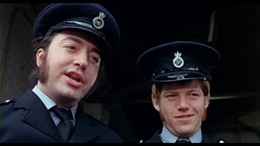 which earns the sympathy of middle class Chris (Kemp). Meanwhile Keith is trying to get back to his no-good crook dad, who turns out to be a planning a bank job.
which earns the sympathy of middle class Chris (Kemp). Meanwhile Keith is trying to get back to his no-good crook dad, who turns out to be a planning a bank job.
Amidst the mayhem you also get a couple of crooks posing as cops (Lake and sex comedy staple Askwith) and a small but colorful part for Roy Dotrice, doing a quirky Fagin imitation. Director David Eady (a familiar CFF name with titles like Where's Johnny?) shows a sure hand right from the creative opening credits, and the vivid cinematography has a rich, pop art look that feels like something right out of a '70s children's book. Fun stuff all around.
Things take a grittier turn with the third and last film of the set, Terry on the Fence, which was shot near the end of the CFF's run and is the only entry shot in 16mm rather than 35mm. It's also the slightest story as prepubescent Terry (McNicholl) decides to give his parents some grief by running away from home. However, the joke's 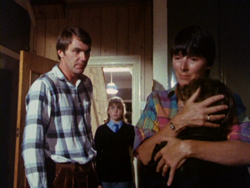 really on him when he falls in with a gang of young thugs led by the creepy Les (Watson). By locking Terry in a cage, they manage to coerce him into going along with a plan to steal a batch of transistor radios from his school. Not surprisingly, Terry finds himself in a moral gray area from which he will find it difficult to escape. Once again this is a fascinating snapshot of a very particular moment in time, both for the state of youth entertainment (which was starting to look more than a little shady) and the condition of the CFF, which was getting trounced by television and family films
really on him when he falls in with a gang of young thugs led by the creepy Les (Watson). By locking Terry in a cage, they manage to coerce him into going along with a plan to steal a batch of transistor radios from his school. Not surprisingly, Terry finds himself in a moral gray area from which he will find it difficult to escape. Once again this is a fascinating snapshot of a very particular moment in time, both for the state of youth entertainment (which was starting to look more than a little shady) and the condition of the CFF, which was getting trounced by television and family films 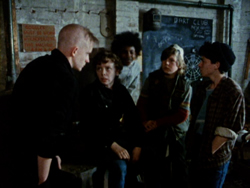 on the big screen. The punk-inspired Les is a particularly fascinating ingredient here, looking like the spawn of Johnny Rotten as he puts our helpless hero through his paces.
on the big screen. The punk-inspired Les is a particularly fascinating ingredient here, looking like the spawn of Johnny Rotten as he puts our helpless hero through his paces.
In keeping with past releases, all three films feature new HD transfers from the original elements kept by the CFF. Only the second film is widescreen, presented anamorphically enhanced at 1.85:1 and looking incredibly good with a color palette that often rivals a vintage MGM musical. The other two are full frame as originally shot, with the third looking the weakest thanks to the format in which it was shot and the grainy darkness in which much of it is set. The sole extra is the usual liner notes booklet complete with fun essays about the films by Kemp and Bernard Ashley (author of the source novel for Terry), plus additional notes on the series and the individual films by Rachel Moseley, Robert Shail, Michael Brooke, and Vic Pratt.
Reviewed on April 7, 2014.


 After dabbling in stories about London, racing, the supernatural, and general freakiness, the BFI's
After dabbling in stories about London, racing, the supernatural, and general freakiness, the BFI's  fascinating, ongoing retrospectives devoted to the films of the Children's Film Foundation turns to an obvious subject: runaways. Previous entries have been filled with tykes scrambling all over the UK, but here the theme of pursuit takes center stage with pint-sized heroes facing moral ambiguity and tricky adults from the '50s into the '80s.
fascinating, ongoing retrospectives devoted to the films of the Children's Film Foundation turns to an obvious subject: runaways. Previous entries have been filled with tykes scrambling all over the UK, but here the theme of pursuit takes center stage with pint-sized heroes facing moral ambiguity and tricky adults from the '50s into the '80s. to the real jewel of the set, 1972's Hide and Seek, a wildly inventive and entertaining slice of colorful fun with an unexpected early role by a very young Gary Kemp, who would go on to co-found Spandau Ballet and star with his younger brother, Martin, in The Krays. Here he plays second fiddle to Peter Newby as Keith, a runaway from a school for troubled kids who gets branded as the "Deptford Dodger" thanks to his petty thefts. He's basically a hungry kid, though,
to the real jewel of the set, 1972's Hide and Seek, a wildly inventive and entertaining slice of colorful fun with an unexpected early role by a very young Gary Kemp, who would go on to co-found Spandau Ballet and star with his younger brother, Martin, in The Krays. Here he plays second fiddle to Peter Newby as Keith, a runaway from a school for troubled kids who gets branded as the "Deptford Dodger" thanks to his petty thefts. He's basically a hungry kid, though,  which earns the sympathy of middle class Chris (Kemp). Meanwhile Keith is trying to get back to his no-good crook dad, who turns out to be a planning a bank job.
which earns the sympathy of middle class Chris (Kemp). Meanwhile Keith is trying to get back to his no-good crook dad, who turns out to be a planning a bank job.  really on him when he falls in with a gang of young thugs led by the creepy Les (Watson). By locking Terry in a cage, they manage to coerce him into going along with a plan to steal a batch of transistor radios from his school. Not surprisingly, Terry finds himself in a moral gray area from which he will find it difficult to escape. Once again this is a fascinating snapshot of a very particular moment in time, both for the state of youth entertainment (which was starting to look more than a little shady) and the condition of the CFF, which was getting trounced by television and family films
really on him when he falls in with a gang of young thugs led by the creepy Les (Watson). By locking Terry in a cage, they manage to coerce him into going along with a plan to steal a batch of transistor radios from his school. Not surprisingly, Terry finds himself in a moral gray area from which he will find it difficult to escape. Once again this is a fascinating snapshot of a very particular moment in time, both for the state of youth entertainment (which was starting to look more than a little shady) and the condition of the CFF, which was getting trounced by television and family films  on the big screen. The punk-inspired Les is a particularly fascinating ingredient here, looking like the spawn of Johnny Rotten as he puts our helpless hero through his paces.
on the big screen. The punk-inspired Les is a particularly fascinating ingredient here, looking like the spawn of Johnny Rotten as he puts our helpless hero through his paces.